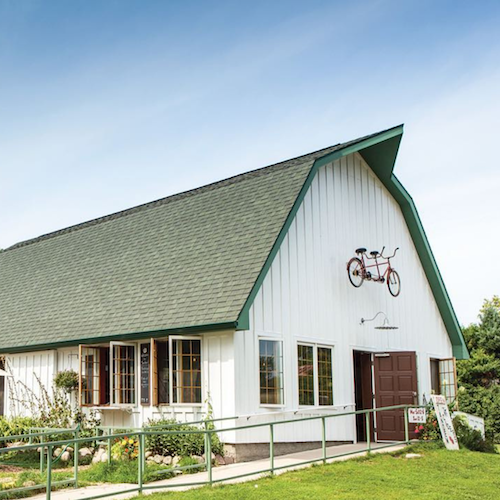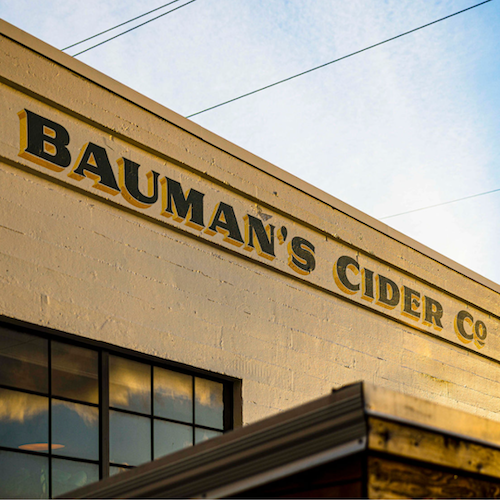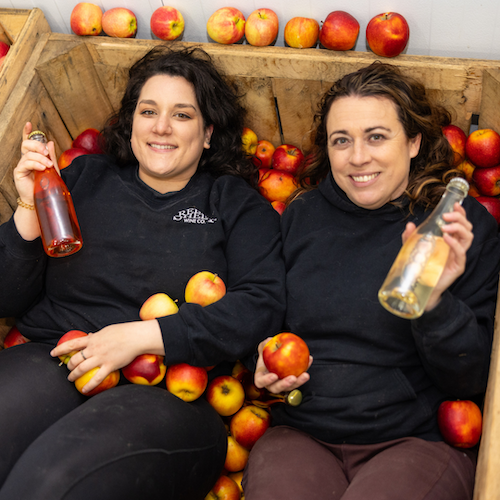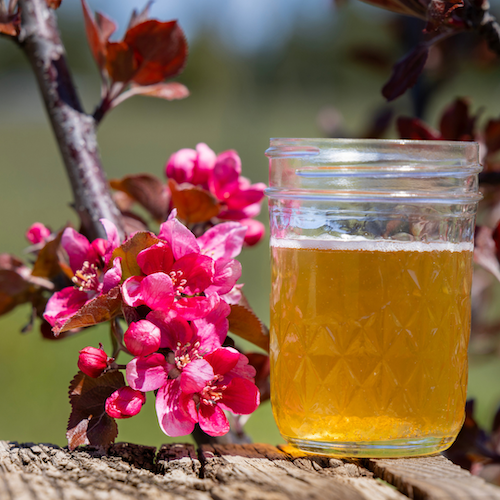Posts by Woodley Smith
November 13: Live Sensory Analysis Webinar with Tandem Ciders

You’re invited to a Live Sensory Analysis webinar on Wednesday, November 13, from 4:00 to 6:00 PM Pacific Time!
Join our Certified Pommelier panel as they guide you through an immersive sensory experience featuring cider from Tandem Ciders from Michigan. During this live practice session, you’ll learn how to analyze and appreciate cider like a pro and prep for your Certified Pommelier exam.
Not able to make it to the live event? No worries! The webinar will be recorded and available for you rewatch at any time with your initial purchase.
Cider must be purchased separately. Please be aware that it may take several days to receive your cider order, so we encourage you to purchase your ciders as soon as possible. Also, please verify that cider can be sent to your state before purchasing ciders. Ciders can be purchased directly from Tandem Ciders by clicking here.
Cost to register for the webinar is $30 for non-members and $20 for ACA members. Are you an ACA member? You can find your discount code in the Resource Hub by clicking here.
Once registered, you will receive a confirmation email. This email is a placeholder for the event. The evening before the event you will receive an email with a Zoom link to the webinar. Please note this link will be sent to the registered email.
November 18: Level 1 Certified Cider Guide Workshop at Bauman’s on Oak
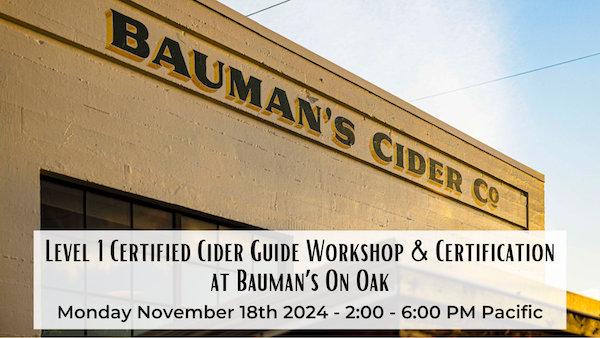
Join us on Monday, November 18, 2024 from 2:00 – 6:00 PM Pacific!
The American Cider Association is excited to collaborate with Bauman’s On Oak to host this Certified Cider Guide Workshop, which includes a tasting experience and certification opportunity.
This workshop is meant for all, and is the first level of the American Cider Association’s in depth international cider education program, Certified Cider Professional.
We have a wonderful afternoon planned including a Certified Instructor led in person training, including an “introduction to sensory evaluation” tasting experience featuring the five cider families. Participants of this workshop will also be able to take the test online immediately after the training or take the test at a later date.
Cost per person is $189 which includes the in person training, instructor led tasting experience, downloadable study guide, cidery tour and online exam fee. Please note that ACA members will receive $50 off registration. Members can find the discount code in the Resource Hub by clicking here.
All are welcome! Please share this event with anyone who sells cider, works in a tasting room or retail shop, chefs, sommeliers, cicerones, buyers and cidermakers who are interested in cider education or in adding a cider certification to their accreditation or cider fans who want to up their cider street cred.
Schedule
- 1:45 PM: Arrival and Check-in
- 2:00 – 5:00 PM: Presentation (with breaks)
- 5:00 – 6:00 PM: Tasting Experience
- 6:00 PM: Take the Online Level 1 Certified Cider Guide Test (bring your own laptop)
- 6:30 PM: Cidery Tour and Networking
2025 ACA Award Nominations
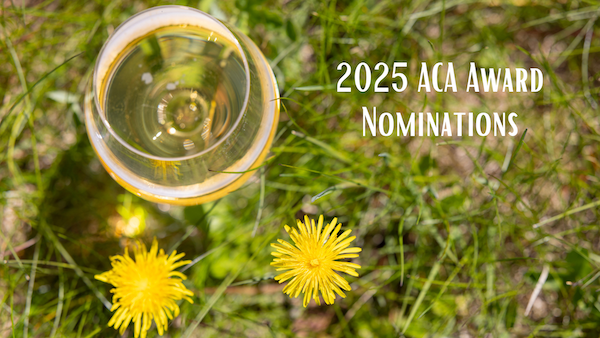
The American Cider Association is pleased to announce that we have opened nominations for the ACA Awards for folks who are doing great things for cider! We welcome your nominations for businesses and people who have been excellent ambassadors for cider in the last year.
Please nominate only one business or person per category. Businesses should not be cideries, but those who help promote cider through their support of cideries and cidermakers. Please submit your nominations by December 1, 2024. Only submissions from active members will be accepted.
We will be presenting awards in each ACA defined region in the following categories:
- Best Cider Retailer
- Best Cider Focused Establishment
- Best Cider Distributor
- Cider Advocate of the Year: A cider tender that excels at promoting cider (Cidery employees can nominated for this award)
- Excellence in Leadership within the Industry (ACA Member)
- Significant Impact on the Industry
- Apple Advocate of the Year: an individual that excels at being an ambassador to the fruit
Awards will be presented at CiderCon® 2025!
ACA Announces 2025 Cider is for Everyone Scholarship Recipients

The American Cider Association (ACA) is thrilled to announce the awardees of the ACA’s 4th Cider is for Everyone Scholarship. Recipients are Marcio Buffolo, head cidermaker at Mountain West Hard Cider; Renaldo Haynes Sr., home brewer and meadmaker; Joanne Mumbey, founder of BeyLoved Pairings LLC and bartender at Green Bench Brewing Co.; Jonathan Osei, National Urban Fellow and Workforce Development Fellow at Project for Pride in Living; Lisa Suarez-Tadus, owner and winemaker at Suárez Wines; and Whitney Williams, food and drink content creator at @workout.to.eatout_pdx. (Photos and bios below.)
This scholarship is designed to bring individuals from historically marginalized populations within the beverage industry to CiderCon® to increase the accessibility of cider education and catalyze networking opportunities for burgeoning cider professionals.
Each scholarship includes registration, travel, and lodging to attend CiderCon® 2025 in Chicago, Illinois. CiderCon® is the world’s premier networking and educational event for the professional cidermaking community. Additionally, scholarship recipients receive a year of ACA membership and study materials and waived exam fees to pursue recognition through the Certified Cider Guide and Certified Pommelier education and certification programs offered by the ACA. New this year, scholars are also eligible for travel stipends to participate in cider judging at various cider competitions throughout the country after earning their credentials as Certified Pommeliers.
This scholarship is part of a broader effort by the ACA to advocate for diversity, equity, and inclusion within the cider industry. In 2019 the ACA launched the Antiracism, Equity and Inclusion Committee, which recognizes diversity, equity and inclusion as important and necessary principles for the present and future successes of the cider industry. Its members, in conjunction with the rest of the organization, strive to create events, opportunities and organizational policies that embody principles and practices of equity and inclusion.
“This scholarship is one of our best tools for fostering a more diverse cider industry,” says Michelle McGrath, CEO of the ACA. “The scholarship needs to work in lock step with our efforts to create a more inclusive industry so that, as we have more diverse CiderCon® attendees, they are surrounded by a welcoming community and equitable environment.”
The ACA is grateful for support from Seattle Cider, Nine Pin Cider and the Great American Beer Festival for sponsoring the Cider is for Everyone Scholarship. Additional companies who wish to support this program should contact miranda@ciderassociation.org.
Please contact Michelle McGrath at michelle@ciderassociation.org for media inquiries. Interested in helping support the Cider is for Everyone Scholarship? Please contact our Membership & Engagement Coordinator Miranda Bradeen at miranda@ciderassociation.org.
###
Meet the Recipients

Marcio Buffolo is from Brazil where he graduated with a degree in biology from Federal University of Rio de Janeiro and a Master’s degree in cell biology. After moving to Utah in 2013, Marcio worked as a scientist at the University of Utah in the Metabolism and Diabetes Department. After a few years, he moved to the fermentation industry where he worked at Shades Brewing for over 6 years. He is now the Head Cidermaker at Mountain West Hard Cider. He is a professional beer judge and cider judge who hold a Certified Cider Guide designation. He is also a professor for the MBAA Malt & Beer course.

Renaldo Haynes Sr. (a.k.a. Ren) is a home brewer looking to transition into professionally and legally selling meads. His love of mead developed from his home brewing experience. Once he transitioned to mead making he discovered his true passion to create and express himself artistically. He has watched in awe as strangers lined up to taste him meads at the Barrel and Flow Festival. In the future, he aims to gain knowledge of cidermaking while incorporating elements of that into his mead making and further change the view of his culture in the industry while showcasing his talents in mead making. Ren is also a proud husband, father, and maker of meads. He is a self-described “Blerd” (Black Nerd), and enjoys sci-fi, fantasy, and comic books, Black history books, hip hop, jazz, and R&B music, and especially anything Batman related. He also enjoys reading, watching anime, and spending time with his family while enjoying a good mead or cider by an evening fire in his yard.

Joanne Mumbey is a Certified Cicerone®, founder of BeyLoved Pairings LLC and currently bartends at Green Bench Brewing Co. which produces beer, cider and mead. She is originally from Uganda, and because of the global nature of her parents’ work she was able to experience various cultures and their cuisines. Her curiosity and love for so many cuisines led her to attend Culinary School at Johnson & Wales University in Providence, RI, where she grew a passion for craft beer. During her time at Green Bench, her first taste of a farmhouse cider opened a whole new world to her and piqued her interest in cider. From that time on she has sought out cider trainings and tastings at Green Bench and beyond to learn more about this wonderful drink. She recently launched BeyLoved Pairings LLC, where she hosts curated beer and food pairing experiences with a focus on diverse cuisines that are typically overlooked in the traditional drinks’ pairing spaces. With this scholarship, she is excited to gain her Pommelier certification to expand her food pairings to include cider.

Jonathan A. Osei, National Urban Fellow and Workforce Development Fellow at Project for Pride in Living in Minneapolis, blends his Arizona roots and Ghanaian-Black Southern heritage to fuel his passion for community work and craft beverages. His journey in the nonprofit social impact space is intertwined with his love for diverse cultures and flavors.
While studying in the Triangle area, Jonathan’s interest in the craft beverage scene blossomed, with Durham introducing him to a variety of craft drinks that broadened his palate. This experience sparked a particular fondness for cider, beginning with Bold Rock Cider and later, Bull City Ciderworks.
In Washington, D.C., Jonathan’s enthusiasm led to his roles as a DC Brand Ambassador for Artisanal Brewing Ventures (and a Beertender at his neighborhood brewery, City State Brewing), sharing exceptional craft beverages. He is committed to diversifying the craft beer and cider industry, actively promoting (DMV) Black brewers through the Black Brew Movement and fostering inclusivity and collaboration. Jonathan’s goal is to enrich the craft beverage culture with diverse flavors and perspectives, bringing people together to enjoy unique and delightful beverages.

Lisa Suarez-Tadus has been making wine since 2011 after a successful television news career in Colorado and Canada. She enrolled in a food and wine school and joined two brother winemakers who just started a winery in Ontario. Her experience in Niagara-on-the-Lake gave her a foundation in winemaking she brings home to Colorado. Today, Lisa is in a new chapter for her wine label, Suárez Wines. She planted more than 1500 cider and cider-crab apples in high density on her farm in Boulder County and is now preparing to dip her skills into producing cider.

Whitney Williams is a food and drink content creator, gym rat and cider enthusiasts from Portland Oregon. She operates an account on Instagram called @workout.to.eatout_pdx where she shares her experiences in the gym and at restaurants and tap houses around Oregon. She has always loved cider and during the pandemic found herself seeking more knowledge around the cidermaking process and becoming a cider club member at many cideries in Portland. Since then, she has been spreading the word about the complexities of cider to anyone who will listen. She hopes to translate her love for cider into hosting and educating people about cider through cider pairing dinners at local restaurants, cider centered events and working with cideries in Portland, Oregon. She hopes her presence in the cider world will inspire other women of color to get involved and chase their dreams.
CiderCon® 2025 Returns to Chicago for the 15th Global Cider Conference and Trade Show

The American Cider Association is pleased to announce that the 15th annual CiderCon® will take place in Chicago, Illinois from February 4-7, 2025. CiderCon® 2025 will feature experiences, cider tastings, educational workshops, a trade show and networking opportunities for all attendees. Attendees of CiderCon® include professional cidermakers large and small, cidery CEOs and employees, apple and pear growers, beer and wine journalists, cider enthusiasts, and beverage retailers and wholesalers.
The ACA has been working with folks on the ground in the Windy City to make CiderCon® 2025 a unique educational experience for cider industry professionals. This includes several experiences to get to know Chicago better while sipping cider.
CiderCon®’s theme this year is: Cider’s Balanced Future: Planet, People, Profit. An emphasis on sustainability, people management, and financial health is reflected in the workshop selections to incorporate the theme. “We know that cider is in its nature a sustainable beverage, but how can we be a sustainable industry? That’s the conversation we’re hoping to have at CiderCon® this year,” said ACA Board President Christine Walter.
Within and beyond the theme, a full range of educational sessions will cover topics of cider production, marketing, sales, branding, sensory evaluation, compliance, business strategy, orcharding and more. The ACA will once again partner with the Cider Institute of North America (CINA) to develop the cider production sessions.
“We have so many amazing sessions already lined up and others in the works, “ said ACA CEO, Michelle McGrath. “It’s been rewarding to think about the impact of CiderCon® on the industry, and to rise to the challenge of deepening that. CiderCon® is very special and we’re committed to improving it every year.”
The ACA is pleased to be welcoming and featuring international cidermaking guests from Chile for CiderCon® 2025. Chile has a long and storied history of cidermaking as an important part of the country’s local culture and economy. Each year, millions of gallons of cider produced from the forests of heirloom cider apples growing in Chile. Most of this cider is sold under the name “chicha” but there is a growing movement of new cidermakers and established companies that are seeking to bring cider to the forefront of the Chilean beverage industry. The Chilean delegation will feature cidermakers, orchardists, educators, researchers, and government officials who are working to bring cider to local, national and international markets.
The extensive trade show, presented by long-standing ACA partner FruitSmart, will feature cider-committed specialty vendors excited for the return of CiderCon® to Chicago and welcome several first-time vendors eager to join the cider community.
In addition, Chicago Cider Week will once again coincide with CiderCon® 2025. The week will feature fantastic events and hospitality for cider friends visiting from far and wide. In addition, Cider Summit Chicago will once again take place at Navy Pier on Saturday, February 8.
CiderCon® 2025 will be held at the beautiful Chicago Hilton Hotel on Michigan Avenue. Registration is now open to all. Tickets to CiderCon® are just $435 for ACA members if booked by December 13. After December 13, member registration rates will rise to $499. Onsite registration for members is $635. Public tickets are $795 until December 13, and $859 after December 13. Public onsite tickets are $995.
More information about the wide array of events and educational sessions being offered and registration can be found on the CiderCon® website and you can follow @ciderconference on Instagram for the latest news. CiderCon® is an ACA event produced with the generous support of our members and ACA’s premier sponsor, FruitSmart.
###
CiderCon® 2025 Tasting Sessions

From quince to mistelles to keeved cider, CiderCon® 2025 tasting sessions will provide something for everyone! Check out the full list and be sure to add them on during registration.
Does Cider Need Tannin?
Price: $12
Speakers: Tom Oliver, Kari Williams, Christine Walter, Scott Katsma
Date & Time: Thursday, February 6, 10:30 – 11:45 AM
What is tannin, where does it come from and why it is needed for flavor and balance in cider. What are the challenges to growing tannic cider fruit varietals? How do you best balance the holy trinity of tannin, acidity and sweetness/alcohol holy trinity in cider making? And what is the consumer’s view and the benefit to them of tannin? Attendees will gain an appreciation of the integral part that tannins play in quality cider and the importance of this pillar of cider making.
Porter’s Perfection: West of England to the PNW
Price: $12
Speakers: Adam Wells, Albert Johnson, Autumn Stoscheck
Date & Time: Thursday, February 6, 2:00 – 3:15 PM
Apple varieties are the engine room of cider’s flavour, and as the global cider revolution grows, so the distinct characteristics of individual varieties are becoming ever more treasured and celebrated. Classic bittersweet and bittersharp varieties from the UK are even crossing the Atlantic to find homes in American orchards, and taking on new directions of flavour from region to region.
One such apple is the fantastic Somerset bittersharp, Porter’s Perfection. A standout in the orchard for its curious habit of fusing multiple apples together as one, it’s an unusual example of a British variety seemingly more often seen on US labels than in the UK.
In this tasting and panel discussion we’ll shine a spotlight on Porter’s Perfection made in both its west English home, and in multiple regions of the USA, discovering both the flavours inherent to this treasured apple variety and the unique inflections of flavour that each country and region brings to the glass.
A Chef’s Guide to Creating Cider Cocktails
Price: $15
Speakers: Chandler Tomayko
Date & Time: Thursday, February 6, 3:45 – 5:00 PM
In this session you will explore the world of cider cocktails told from a chef’s perspective. Chef and bartender Chandler Tomayko of BevFluence® will take you on a journey from cider to cocktail and everything in between. Learn how to craft delicious cocktails using both high tannin and low tannin ciders, paired with seasonal ingredients and culinary techniques that elevate traditional drinks into something truly special. Tastings include 2 ciders and 2 cider cocktails made from the featured ciders.
Keeving: Basics and Practical Applications
Price: $12
Speakers: Dave Takush, Dion Stepanski, Yann Gilles, Christine Walter
Date & Time: Thursday, February 6, 3:45 – 5:00 PM
Explore the traditional cidermaking technique of keeving in this focused session. Learn the core principles and practical applications of keeving across various production scales. The panelists will provide insights into their keeving methods, share key techniques, and discuss the impact on cider quality. The session will also feature a tasting of different keeved ciders, allowing attendees to experience the results of this unique process firsthand. Gain valuable knowledge on how to effectively implement keeving in cider production.
Brewer’s Yeast in Cider for Unique Flavor & Branding
Price: $12
Speakers: Brian Wing, Andy Diacetis, Jen Curs
Date & Time: Friday, February 7, 10:30 – 11:45 AM
This session will explore how new yeast strains are developed and brought to market. Trials were developed using nine different brewing yeast strains on bulk apple juice. The audience will learn about the analytical results and tasting data from these ciders so they can take home ideas for their own experimentation. There will be three ciders to taste during the session made with brewing yeast strains.
Chilean Cider: Honoring Rich Traditions
Price: $12
Speakers: Eli Shanks, Jose Antonio Alcalde, Fabian Lara, Harriet Nahrwold, Carlos Martinez, Gicella Saldivia, Rene Galindo
Date & Time: Friday, February 7, 10:30 – 11:45 AM
Chile has a long and storied cidermaking history with 500 years of culture and livelihoods built around cider, and dozens of endemic, true cider apple varieties. A new generation of cidermakers are building off of this tradition and bringing new energy and innovation into the industry, and are coming to CiderCon 2025 to share their ciders and their stories with you. From a multi-generational, Native Chilean family cidery, to the very people responsible for identifying and classifying the distinct and unique Chilean cider apples, to the most envelope-pushing producers of the day, this tasting session will be filled with overlooked history, a reflection of a modern reality for cidermaking in a place unlike anywhere else in the world, and ciders made from apples that have never been grown or even tasted in North America. Don’t miss it.
How to Evaluate Ciders for the Certified Pommelier Exam
Price: $12
Speakers: Jennie Dorsey, Tim Powers, Kate Pinsley
Date & Time: Friday, February 7, 2:00 – 3:15 PM
Participants will practice blindly evaluating two ciders using the ACA’s Structured Sensory Evaluation process guided by Certified Pommelier and Education Operations Director Jennie Dorsey and a panel of Certified Pommeliers. This session will teach you how to objectively assess any cider, empowering you in the cidery and in assisting customers to find a cider they love while also helping you to prepare for the sensory portion of the Certified Pommelier exam.
The Paradigm of Natural Cider Production
Price: $12
Speakers: Haritz Rodriguez, TBD
Date & Time: Friday, February 7, 2:00 – 3:15 PM
The definition of natural cider varies depending on how you look at it. In Spain it is regulated by law, which perfectly defines what can be considered natural cider. However, the concept of natural cider goes beyond a style and differs in other places, depending on the philosophy of each cider maker. Biodynamic agriculture, organic agriculture, no addition of sulfites (at any point in the process?), spontaneous fermentation without added yeasts, no stabilization… What’s the paradigm of natural cider? In this debate we want to explore the limits of natural cider and define the paradigm. What is it that all those producers want the consumer/purchaser to understand by the word natural and what is it that the consumer thinks they are purchasing when buying or asking for “natural cider”?
Apple Mistelles: History, Production and Enjoyment
Price: $15
Speakers: Jennie Dorsey, Yann Gilles, Ambrosia Borowski
Date & Time: Friday, February 7, 3:45 – 5:00 PM
Apple mistelles, a lesser-known yet richly flavorful beverage, have been gaining appreciation for their unique blend of history, craftsmanship, and taste. In this session, participants will delve into the fascinating history of apple mistelles, learning about their production process and the distinct characteristics they offer. Through a guided tasting, you will explore the full range of flavors that mistelles can provide—from sweet and rich to crisp and aromatic—while gaining a deeper understanding of their role in the wider world of apple-based beverages.
Embracing Quince: A Sensory Exploration in Cider
Price: $12
Speakers: Brandon Buza, Jose Antonio Alcalde, Rene Galindo Quidel
Date & Time: Friday, February 7, 3:45 – 5:00 PM
The use of quince in cider, as a blended ingredient or as a featured single varietal, has grown in recent years given a passionate fan base. Although quince is known for contributing unique floral aromas, customers, buyers, sommeliers and makers are still learning about this mysterious fruit. The full extent of what it can bring to a cider when done right is little known. In this session, participants will join us for a visual and sensory introduction to this exciting pome, carefully tasting through a flight of quince ciders to arrive at a better understanding of what quince offers to a cider’s aroma, structure and flavor when alone or when interacting with apples.
TTB Reopening Comment Period on Proposed Standards of Fill
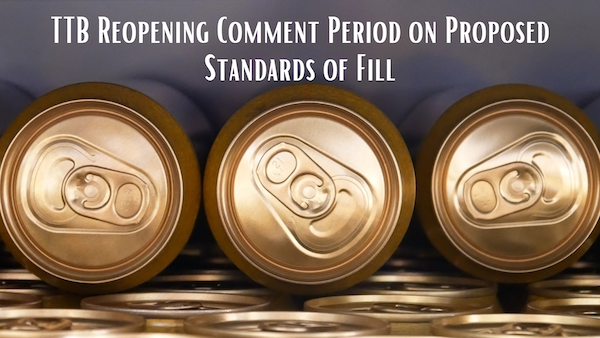
The TTB has opened a comment period on proposed additions to the standards of fill (Notice 210A) — including additions to the approved packaging sizes for wine, cider and mead over 6.9% ABV. The comment period will close on Oct 9, 2024 and the ACA is encouraging cideries and cider enthusiasts to submit comments in support of 16 oz (475 mL) and 19.2 oz (570 mL) packaging volumes for cider, mead and wine over 6.9% ABV. Comments can be submitted through the TTB’s website: SUBMIT COMMENTS HERE.
The ACA supports these additional standards of fill for cider because:
- Not having these common beverage alcohol packaging sizes cuts cider out of innovation opportunities driven by consumer demand.
- Lack of these packaging volumes puts cider at a disadvantage compared to beer and beyond-beer products taxed like beer, such as flavored-malt-beverages, who have access to these packaging volumes.
- Cider is an agricultural product made from apples. Apples will ferment to a higher ABV naturally depending on the weather that harvest season. Warmer temperatures equate to higher sugar levels resulting in higher alcohol levels. Making packaging decisions after fermentation is not a viable business model.
The American Cider Association is a staunch advocate for fair access to additional packaging sizes for cider, mead and wine over 6.9% ABV. In 2020, the TTB approved 355 ml (12 oz), 255 ml, and 200 ml packaging sizes in part as a response to ACA and ACA member petitions. In 2022, we petitioned for 16 oz (475 mL) and 19.2 oz cans (570 mL) for cider, mead and wine over 6.9% ABV and we have been advocating for their addition to permitted standards of fill ever since. In response to our inquiries, the TTB included 16 oz (475 mL) and 19.2 oz (570 mL) packaging volumes in their proposed rule. The summary of our comments can be found in Notice 210A.
Please join us in supporting the addition of 16 oz (475 mL) and 19.2 oz (570 mL) packaging volumes for cider, mead and wine. Be sure to submit your comments before October 9.
ACA Welcomes 15 Certified Pommeliers Following Washington & Minnesota Exams

The American Cider Association is pleased to announce that 15 individuals successfully passed the recent Certified Pommelier exams held in Bellingham, Washington and Minneapolis, Minnesota. The new Certified Pommeliers are Kathleen Amaral, Assistant Production Sensory Manager with the Boston Beer Company; Eliseo Bell-Uribe, owner and head cidermaker at Heartland Ciderworks; former cidermaker and lifelong cider enthusiast Rachel Bolongaro of Canada; Taylor Corrigan from Finnriver Farm & Cidery; Mikey Crews, owner/operator of Wine Grapes Direct; cider enthusiast Ava Davis of Washington; Christian Scott Junes, cidermaker at Wild State Cider and owner of Borealis Beverage Company; Greg Kodgis, lead bartender and cocktail coordinator at Number 12 Cider; Alexander Logan, Cidermaker for 19 Acres Cider Co.; Kyle McLennan, co-founder and president of 19 Acres Cider Co.; Brighid O’Keane, Executive Director of the Cider Institute of North America (CINA); cider enthusiast Matt Spiess of Nashville, Tennessee; Adam Wargacki from Empyrical Orchards and Cider & Cidery; cidermaker Maia Wohlert from Greenwood Cider; and cider enthusiast Rosie Zollinger from Australia.
“We are so proud to welcome the new Certified Pommeliers to our vibrant community dedicated to elevating the appreciation and understanding of cider,” says ACA Education Operations Director Jennie Dorsey. “Each new member brings with them the stories of orchards, the craftsmanship of cidermakers, and the passion of enthusiasts that makes our community thrive. We are very excited to see what the future holds and the new heights that our community can reach together.”
Early on, the American Cider Association recognized the need to promote specialized knowledge about the cider category. Certifications are increasingly being used to set food and beverage professionals apart. However, most certification programs cover cider in a cursory manner or not at all. With cider being a beautifully nuanced beverage with a diverse set of elements often less understood by food and beverage professionals, the establishment of the Certified Cider Professional (CCP) program in 2016 was a strategic maneuver.
Today, the CCP program is designed to educate those on the front-line of cider sales, making it the world’s most comprehensive and in-depth cider appreciation program for food and beverage professionals worldwide.
“We know that consumers respond to engaged servers, and that confident recommendations go a long way in influencing their purchase decision. Our theory of change is that cider enthusiasm is contagious–CCP is how we keep the flame growing,” says ACA CEO Michelle McGrath.
###
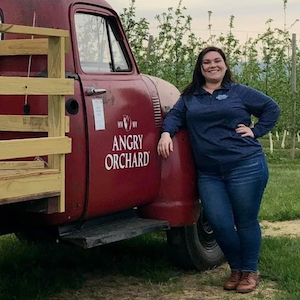
Kathleen Amaral
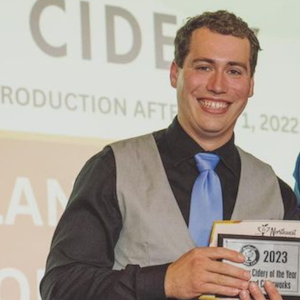
Eliseo Bell-Uribe
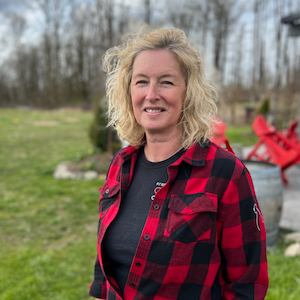
Rachel Bolongaro

Taylor Corrigan

Mikey Crews

Ava Davis

Christian Scott Junes

Greg Kodgis
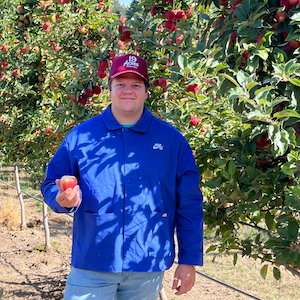
Alexander Logan

Kyle McLennan
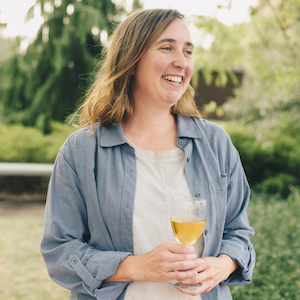
Brighid O’Keane

Matt Spiess

Adam Wargacki
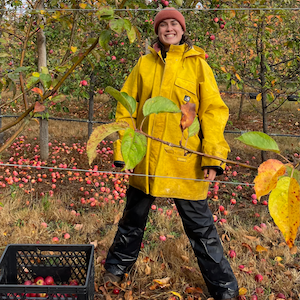
Maia Wohlert

Rosie Zollinger
More about the Certified Cider Professional Program and Upcoming Opportunities
The CCP program begins with a Certified Cider Guide (CCG) Level 1 certification to help industry professionals develop a fundamental understanding of cider. The Certified Pommelier (CP) Level 2 takes it a step further by encouraging cider professionals to think critically and showcase a higher level of understanding of the elements of cider. The rigorous testing process consists of four types of questions, including short answer, fill in the blank, essay, and blind sensory–which is based on tasting.
The ACA is dedicated to ensuring that all information tested on the exam is made accessible to anyone who desires to learn. To that end, the ACA released a textbook in March of 2023 to help candidates prepare to take the exam with just one comprehensive resource. The second edition of the textbook was released in March of 2024 to present a more global view of the cider industry as well as including new sections covering important emerging sectors such as low and no-alcohol products.The textbook is available for purchase through Kindle Direct Publishing. Additionally, the ACA offers sensory analysis practice webinars and a Facebook study group continuously updated with resources for exam candidates. Interested candidates can find links to all Certified Pommelier resources on the ACA website.
For those interested in attaining their Certified Pommelier designation, there are several upcoming exams to choose from:
Contact the ACA’s Education Operations Director Jennie Dorsey if you have questions about the Certified Cider Professional program or are interested in taking either the Level 1 Certified Cider Guide or Level 2 Certified Pommelier exams. You can also learn more at https://ciderassociation.org/certification.
Member Highlight: Rebel Sheep Wine Co.

Cidery Name:
Where are you located and when did you start?
Located in Chester, New Jersey. Opened in 2024
Describe your cidery in three words:
Innovative, sustainable, rebellious
What inspired you to start making cider?
We farm around 500 acres in our area. In 2021 our apple crop came into full production, and we had an abundance of apples. We decided making cider would be a great addition to our farm and a unique way to cut down on food waste.
Describe your cider making style:
Spontaneous. We use only our own apples and focus on using all natural ingredients from our farm that bring out the best qualities of New Jersey fruit. We rely on the seasons to decide what cider we make.
What is your favorite cider that you make?
Hopposites Attract. We blended a cider with a strawberry wine and then dry hopped it.
What exciting plans or new releases do you have coming up:
A lot of plans are in the works. We just opened in 2024 so we are still figuring out what blends we like and what our signature flavors will be.
Where can cider enthusiasts find your products?
Our tasting room and various farmers markets that we attend throughout Northern New Jersey.
What’s your favorite way to enjoy cider?
With our homemade Apple Cider Donuts.
What’s one piece of advice you would give to someone new to making cider or wanting to start a cidery?
Don’t get discouraged when your cider does not turn out perfectly. Trial and error is part of the process until you find out what works best.
What are your hobbies or interests outside of cidermaking?
Farming 500 acres of fruits and vegetables doesn’t leave a lot of time for hobbies, but attending workshops and listening to cider and wine podcasts is enjoyable.
Is there anything else you’d like to share with our readers?
New Jersey has farms and makes great wine and cider! We are the Garden State for a reason!
2025 Board Nominations Now Open

Do you have a passion for growing the cider industry? Are you looking to find a platform for your ideas, where you will be seen and heard? Would you like to work with a group of like-minded industry leaders to create positive change?
Five seats on our Board of Directors are up for grabs in 2025. Seats that will be up for election this year are as follows: 1 Large Cidery Seat, 1 Regional Chair – South, 1 Regional Chair – East, 1 Regional Chair – Pacific Coast, and 1 At-Large Seat. Our annual nomination window is now open, and we want to hear from you!
Elections will take place electronically during CiderCon® 2025 in Chicago, Illinois on February 6-7. All U.S. member cideries are eligible to vote (1 vote per cidery).
Although it is not required, we strongly encourage candidates to have an ACA volunteer history before running for office.
Please see below for more specifics on service and how to apply:
- Positions are open to any active ACA member cidery in the U.S., regardless of size.
- Applications are due by November 14th, 2024.
- To qualify for candidacy, you must be a permanent employee of a bonded cidery, producing cider in the U.S.
- Incumbents may be running for their seats again.
- Terms are three years.
- Applicants will be reviewed when the submission window has closed
- Qualified candidates will receive further instructions on developing their platforms and what board service includes.
Have more questions about board service? Schedule a chat with ACA CEO Michelle McGrath by clicking here.
To submit your nomination by the November 14th deadline fill out the self-nomination form.

